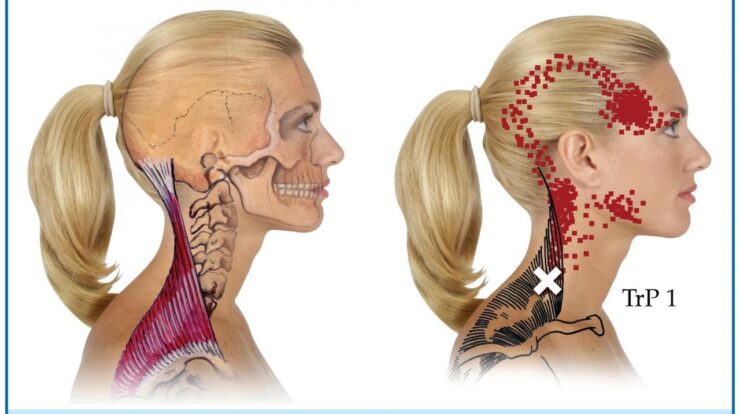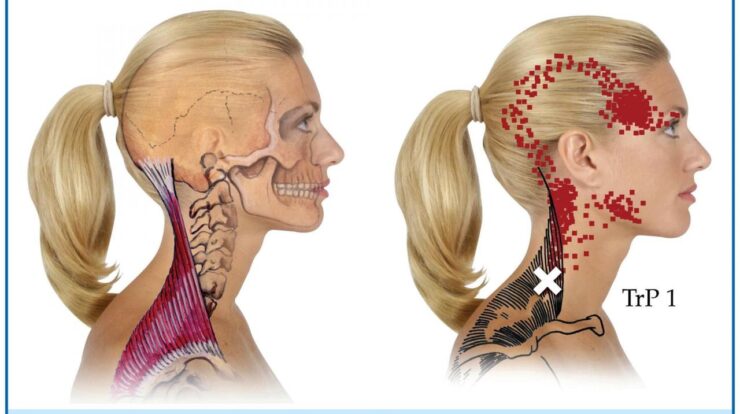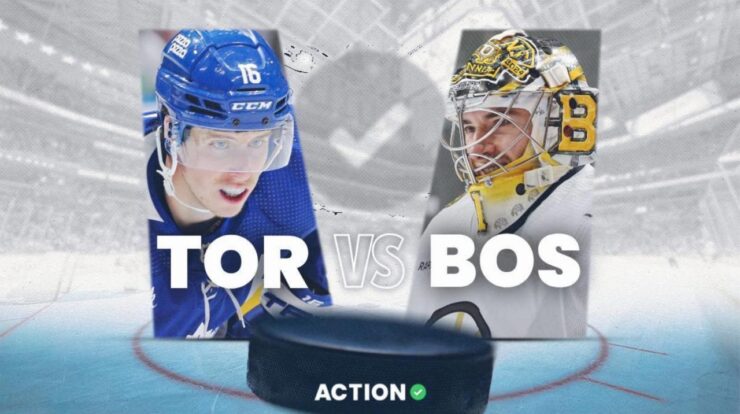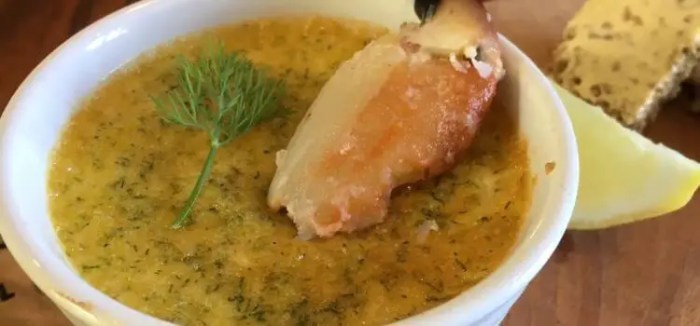
Crab brulee recipe – Indulge in the exquisite world of crab brulee, a culinary masterpiece that tantalizes taste buds and captivates the senses. This delectable dish seamlessly blends the rich flavors of crab with the velvety smoothness of a custard base, topped with a golden-brown caramelized crust.
Embark on a culinary journey as we delve into the secrets of crafting this extraordinary dish, from selecting the finest ingredients to mastering the art of presentation.
Ingredients and their benefits
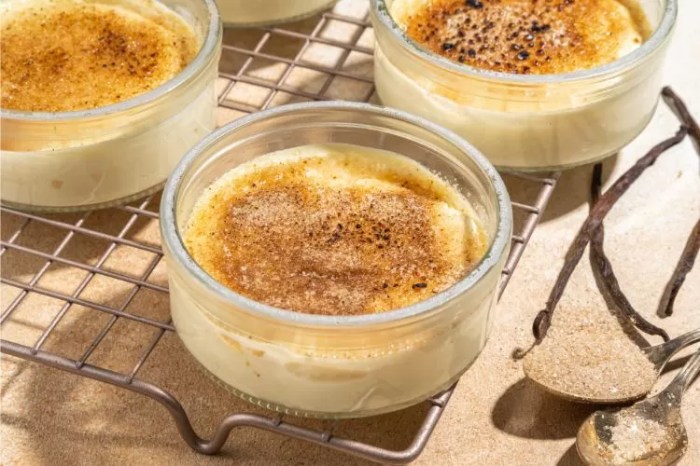
Crab brulee is a delicious and elegant dish that is perfect for a special occasion. It is made with fresh crab meat, cream, eggs, and cheese, and it is topped with a crispy, caramelized sugar crust. The key ingredients in crab brulee are all packed with nutrients, making it a healthy and satisfying dish.
Crab meat is a good source of protein, omega-3 fatty acids, and vitamins B12 and D. Omega-3 fatty acids are essential for heart health, and they have been shown to reduce the risk of heart disease, stroke, and cancer. Vitamin B12 is important for nerve function and red blood cell production, and vitamin D is important for bone health.
Cream is a good source of calcium, protein, and vitamin A. Calcium is important for bone health, and it can help to prevent osteoporosis. Protein is essential for building and repairing tissues, and vitamin A is important for vision and immune function.
Eggs are a good source of protein, vitamins A, D, and E, and minerals such as iron and zinc. Protein is essential for building and repairing tissues, and vitamins A, D, and E are all important for immune function. Iron is important for red blood cell production, and zinc is important for immune function and wound healing.
Cheese is a good source of calcium, protein, and vitamins A, D, and K. Calcium is important for bone health, and it can help to prevent osteoporosis. Protein is essential for building and repairing tissues, and vitamins A, D, and K are all important for immune function.
Nutritional comparison of different crab species
The nutritional content of crab meat can vary depending on the species of crab. The table below compares the nutritional content of three common crab species: blue crab, Dungeness crab, and snow crab.
| Nutrient | Blue crab | Dungeness crab | Snow crab |
|---|---|---|---|
| Calories | 90 | 100 | 110 |
| Protein | 19 grams | 20 grams | 21 grams |
| Fat | 2 grams | 3 grams | 4 grams |
| Carbohydrates | 0 grams | 0 grams | 0 grams |
| Omega-3 fatty acids | 250 mg | 300 mg | 350 mg |
| Vitamin B12 | 1.5 mcg | 2.0 mcg | 2.5 mcg |
| Vitamin D | 10 IU | 15 IU | 20 IU |
As you can see, the nutritional content of crab meat is very similar across the three species. However, snow crab is slightly higher in calories, fat, and omega-3 fatty acids than blue crab and Dungeness crab. Dungeness crab is slightly higher in protein and vitamin B12 than blue crab and snow crab.
Blue crab is slightly higher in vitamin D than Dungeness crab and snow crab.
Importance of using fresh, high-quality ingredients
When making crab brulee, it is important to use fresh, high-quality ingredients. Fresh crab meat will have a sweeter, more delicate flavor than frozen crab meat. High-quality cream, eggs, and cheese will also make a big difference in the taste and texture of the dish.
If you are using frozen crab meat, be sure to thaw it completely before using it. Thawed crab meat can be cooked immediately, or it can be refrigerated for up to 24 hours.
To ensure that your cream, eggs, and cheese are fresh, check the expiration dates on the packaging. You should also avoid using any ingredients that have been opened for more than a few days.
By using fresh, high-quality ingredients, you can make a delicious and elegant crab brulee that will impress your guests.
Step-by-step preparation
Creating a delectable crab brulee involves a meticulous step-by-step process that combines the flavors of succulent crab meat with a rich custard base. Follow these detailed instructions to achieve a perfectly set and indulgent dish:
Preparing the crab meat
Begin by selecting fresh or frozen crab meat and gently flaking it into small pieces. Avoid overworking the crab meat to prevent it from becoming stringy. If using frozen crab meat, thaw it completely before flaking.
Creating the custard base
In a large bowl, whisk together eggs, heavy cream, grated Parmesan cheese, salt, and pepper until smooth. The custard base should be thick and creamy.
Baking and setting the brulee, Crab brulee recipe
Preheat your oven to 350°F (175°C). Lightly grease ramekins or a baking dish. Pour the crab mixture into the prepared ramekins, filling them about 3/4 full. Place the ramekins in a larger baking dish filled with hot water to create a water bath.
Bake for 25-30 minutes, or until the custards are set and have a slight wobble when gently shaken.
Remove the ramekins from the oven and let them cool for a few minutes before serving. Enjoy the rich and flavorful crab brulee!
Variations and serving suggestions
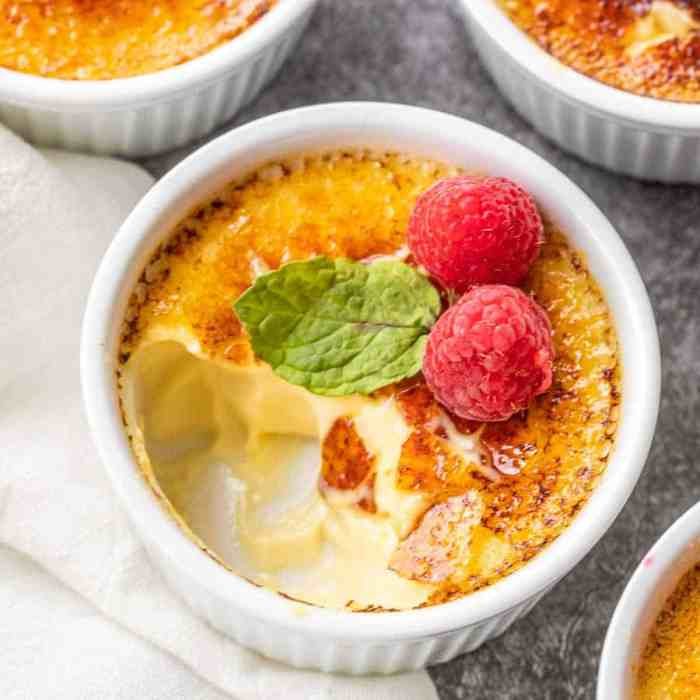
Crab brulee is a versatile dish that can be customized to suit your taste. Here are a few variations to try:
Seafood variations
- Use different types of seafood, such as shrimp, lobster, or scallops.
- Add cooked bacon or pancetta for a smoky flavor.
- Top with a dollop of caviar for a luxurious touch.
Herb and spice variations
- Add herbs such as thyme, rosemary, or tarragon for a fragrant twist.
- Spice it up with a pinch of cayenne pepper or paprika.
- Garnish with fresh chives or parsley for a pop of color.
Dietary variations
- Make a gluten-free version by using gluten-free bread crumbs or almond flour.
- Create a dairy-free version by using almond milk or coconut milk instead of cream.
Serving suggestions
Crab brulee can be served in a variety of ways:
- As an appetizer, serve it in small ramekins with a side of crackers or bread.
- As a main course, pair it with a salad or roasted vegetables.
- As a dessert, top it with a dollop of whipped cream or fruit compote.
No matter how you choose to serve it, crab brulee is sure to impress your guests with its rich flavor and elegant presentation.
Presentation and plating
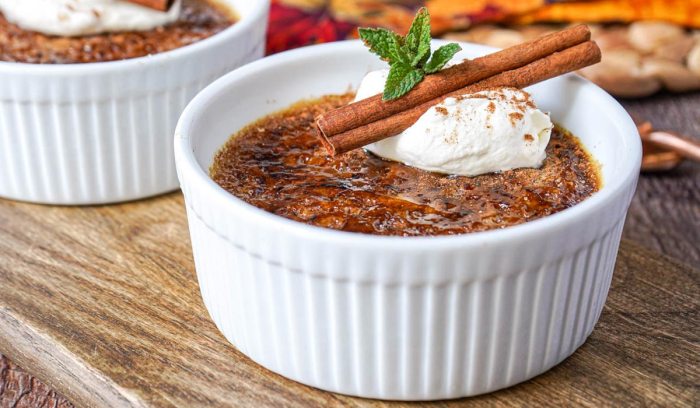
When presenting and plating crab brulee, there are a few things to keep in mind to make your dish visually appealing. First, consider the shape of your ramekins. Round ramekins are classic, but you can also use square or rectangular ramekins for a more modern look.
Once you have chosen your ramekins, it’s time to start plating your crab brulee.
To plate your crab brulee, start by spooning a thin layer of the crab mixture into the bottom of each ramekin. Then, top with a layer of the brulee mixture. You can then use a kitchen torch to brulee the top of the crab brulee until it is golden brown.
Once the crab brulee is bruleed, let it cool for a few minutes before serving.
Garnishes, sauces, and accompaniments
There are many different ways to garnish, sauce, and accompany crab brulee. Here are a few ideas:
- Garnishes: Chopped chives, parsley, or dill
- Sauces: Hollandaise sauce, beurre blanc, or lemon butter sauce
- Accompaniments: Crusty bread, crackers, or a side salad
Plating techniques
There are many different ways to plate crab brulee. Here are a few examples:
| Plating technique | Description | Image |
|---|---|---|
| Classic | Crab brulee is spooned into ramekins and bruleed. | [Image of classic crab brulee] |
| Modern | Crab brulee is plated in a square or rectangular ramekin and garnished with chopped chives. | [Image of modern crab brulee] |
| Elegant | Crab brulee is plated on a bed of hollandaise sauce and garnished with a sprig of parsley. | [Image of elegant crab brulee] |
Troubleshooting and common mistakes

When preparing crab brulee, it’s important to be aware of common mistakes and how to avoid them. Here are some of the most common issues and their remedies:
Mistakes in ingredient proportions
- Using too much or too little crab meat can affect the texture and flavor of the brulee.
- Ensure accurate measurements and adjust the proportions as needed to achieve the desired consistency.
Overcooking or undercooking
- Overcooking the crab mixture can make it tough and rubbery.
- Undercooking can result in a runny and uncooked center.
- Cook the mixture until it sets but is still slightly wobbly in the center.
Incorrect oven temperature
- Using an oven that is too hot or too cold can affect the cooking time and result in uneven cooking.
- Preheat the oven to the correct temperature and ensure it is accurate.
Improper custard preparation
- If the custard is not properly mixed or cooked, it can curdle or become lumpy.
- Whisk the eggs and cream together thoroughly and cook over low heat until thickened.
Uneven browning
- The brulee topping can brown unevenly if the sugar is not evenly distributed or if the dish is not placed in the center of the oven.
- Sprinkle the sugar evenly over the surface and place the dish in the center of the oven for even browning.
End of Discussion: Crab Brulee Recipe

As we bid farewell to our exploration of crab brulee, let us savor the unforgettable flavors and techniques we have encountered. This culinary gem is a testament to the boundless creativity and artistry that can be found in the realm of cooking.
Whether you seek to impress guests at a dinner party or simply treat yourself to a moment of indulgence, the crab brulee recipe will undoubtedly leave a lasting impression. So, gather your ingredients, ignite your culinary passion, and embark on the journey of creating this extraordinary dish.
FAQ Overview
What is the secret to a perfectly caramelized crust on crab brulee?
The key is to use a kitchen torch to evenly caramelize the sugar topping, creating a crisp and golden-brown layer.
Can I use other types of seafood in this recipe?
Absolutely! Feel free to experiment with different seafood options such as lobster, shrimp, or scallops to create unique variations.
How can I make a gluten-free version of crab brulee?
Simply substitute all-purpose flour with a gluten-free flour blend in the custard base.
